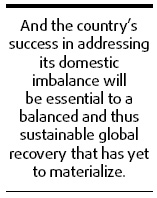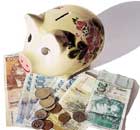Editorials
Rebound may fuel change
(China Daily)
Updated: 2010-01-22 07:45
 |
Large Medium Small |
China's economic growth rate of 8.7-percent for 2009 is faster than the government's projected growth target of 8 percent. It is barely a surprise.
Gross domestic product (GDP) reached 33.54 trillion yuan ($4.91 trillion) in 2009, National Bureau of Statistics director Ma Jiantang said in Beijing yesterday.
While describing the country's economic development in 2009 as a "harvest", he attributed the recovery mainly to the implementation of the proactive fiscal policy and moderately loose monetary policy, as well as the government stimulus package, to cope with the global financial crisis.
| ||||
Yet, a V-shaped rebound that became evident in the third quarter last year has practically wiped out doubt of China's chances to achieve its growth target.
Now, latest statistics show that the world's third largest economy expanded 10.7 percent in the fourth quarter of last year, lifting the full-year growth rate well above the original target.

Compared with its own average annual growth of 9.8 percent for the past three decades, China's economic performance remains subpar. But the recent return of double-digit growth that may continue in following months, if not quarters, has definitely put the country back on track to continue its long-term growth story.
The fact that the worst global recession in decades has not choked a global economic growth engine as important as China is reassuring; Chinese policymakers should take credit for that. Though the global recovery is still fragile, China's accelerated growth helps to boost the international community's morale that the worst part of the financial crisis might be over.
However, if the country is to capitalize on the global economic crisis as it hopes, this strong recovery should merely be the start.
For Chinese policymakers, the task to rebalance a fast-growing, developing economy that is too dependent on investment and exports will only be more demanding and compelling.
As a counter-crisis measure, last year's investment boom fueled by a flood of bank lending and stimulus spending was necessary to cushion the Chinese economy against the global recession. But the 30.1-percent growth of fixed-asset investment year-on-year has made this country rely more on investment for growth.
Besides, there are few signs that the country has made real progress in cutting its dependence on exports, though external demand turned out to be a drag on economic growth last year.
It will take a lot of painful times for China to rebalance away from the previous growth model to embrace consumer-led growth. And the country's success in addressing its domestic imbalance will be essential to a balanced and thus sustainable global recovery that has yet to materialize.
Make rebalancing at home and abroad the theme of 2010 and the new decade.
(China Daily 01/22/2010 page8)













